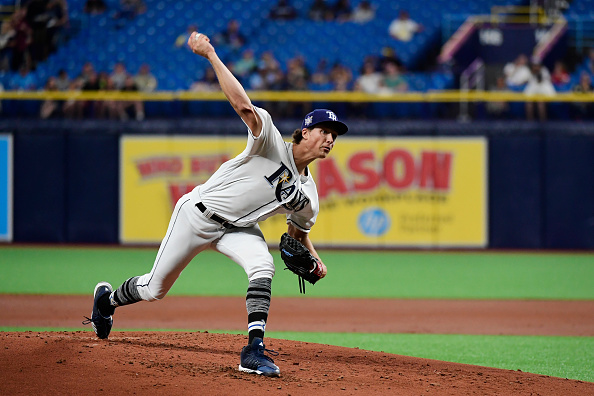Battling his height and shifting between the bullpen and the rotation in Pittsburgh, Tyler Glasnow could be reaching his potential in Tampa Bay. It starts with a pitching coach who understands the mechanics of height as a pitcher, Kyle Snyder, who stands at 6’7” with Glasnow one inch taller. Last year, Glasnow finished with one win of his six decisions as a starting pitcher in 11 games. Entering this season, he owned a WHIP of 1.44 due to his lack of control at times and lack of faith in his four-seam fastball.
This year, Glasnow will start May with five wins against zero losses, a 1.75 ERA, 3.15 FIP and 0.94 WHIP through six starts spanning 36 innings. He’s also surging in regards to strikeouts with 38 against seven walks for a robust 27.7 strikeouts minus walks percentage, which presently ranks 13th among qualified starters. Yes, Glasnow’s ERA accompanies a 90.6 strand rate, which will regress, hence his xFIP. But, even if using Glasnow’s xFIP in the ERA rankings, he’d be 23rd in the league.
Glasnow leads the majors in wins tied with Domingo Germán and Marco Gonzales . Although his swinging strike rate slightly trails last year’s total, Glasnow’s increase in chase rate could offset it. It’s sort of mind-blowing seeing Glasnow’s used his fastball 66 percent of the time through his first 36 innings. Natural movement depresses hard contact and he’s moving it around more. Here’s a look at a heat map of his fastball from last year courtesy of Statcast:
He really concentrated on just throwing strikes last year as evidenced by the dark grouping near the center. However, this season, Glasnow’s been moving his fastball around, as encouraged by his catcher, Mike Zunino :
It’s still early in the season, but this small sample yields encouraging results. Glasnow fares well against hitters from both sides of the plate, so loading a lineup against him may not be effective:
Glasnow versus LHH: .186/.234/.254, .217 wOBA, 19 strikeouts, four walks
Glasnow versus RHH: .229/.260/.343, .261 wOBA, 19 strikeouts, three walks
There’s going to be the regression crowd not willing to buy into Glasnow’s start due to the volatility displayed with Pittsburgh, and it’s understandable. However, check out his statistics so far this year by pitch with the expected numbers also included:
Throwing a four-seam fastball, which Glasnow can cut when necessary, yields the above numbers so far. If, and when Glasnow starts to throw his secondary pitches more, his strikeout rates could increase. Check out the whiff percentage he owns with the curve and the slider. Glasnow also fired eight change-ups against the Red Sox his last start, a season high. There’s not only room for growth, but, a potential uptick in strikeouts even if his ERA will migrate towards his xFIP.
As his arsenal continues to evolve, Glasnow could improve, or more succinctly, once Glasnow uses fewer four-seams and unleashes more sliders, double digit strikeout games will ensue. Here’s a look at his pitches this year thanks to Statcast:
If Glasnow’s owner in your league wishes to sell high, check out the price. In a year with hard-hit rates surging and ERA’s on the rise, getting a young pitcher with upside makes perfect sense. There will be tough outings, it is baseball. But, Tyler Glasnow already represents a pitching value compared to his preseason cost and along with the Rays as a team, enjoying an early season breakout. Best of all, he could be just starting to display his talents.
Statistical Credits:
BaseballSavant.com
Fangraphs.com
MLB.com

